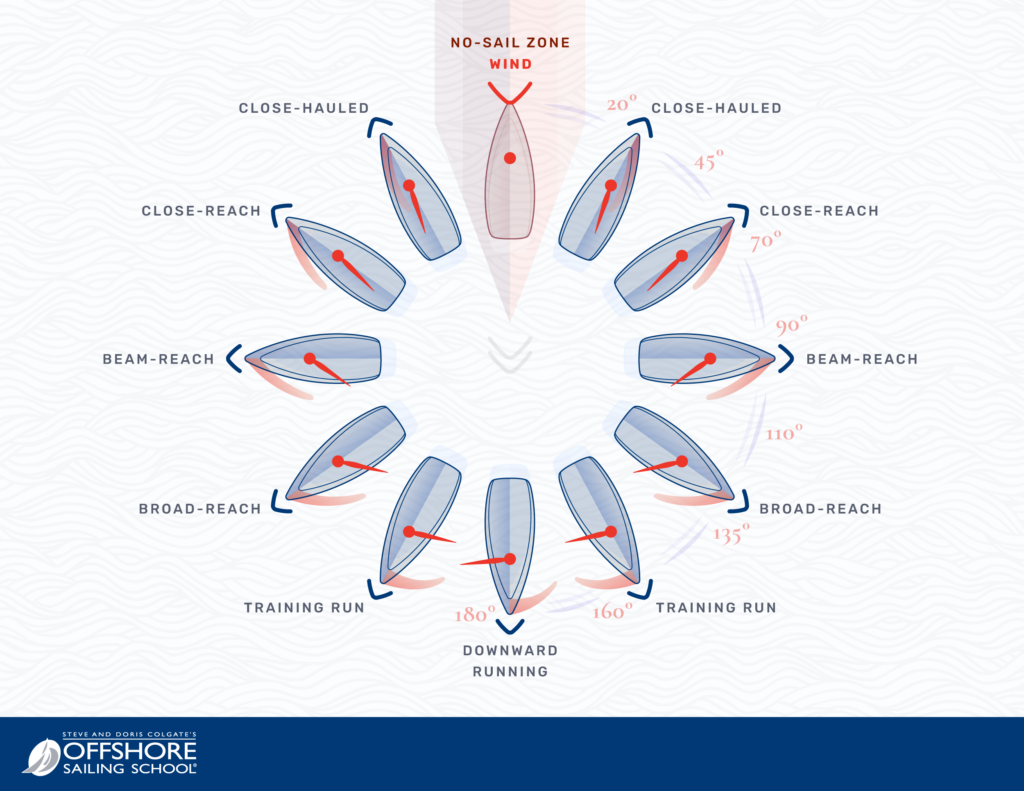Boat sailing is a beautiful pastime. It is an activity that links you to nature. You must harness the wind to get the boat moving forward.
Yet, the direction of the wind is uncontrollable, so you must learn how to direct the wind in your favor. The relationship between the wind angle and the boat’s speed and direction is called the points of sail.
Learning the points of sail is an important skill for any sailor to properly maneuver and control a sailboat.
The Science Behind the Points of Sail
To properly sail a boat you have to understand the theory behind it all. It is impossible for a boat to sail directly in the wind. While that’s obvious, it is important that you truly understand why.
Sails have a triangular shape designed to deflect wind, which propels the boat forward. This only happens when wind is hitting the sail at an angle. Therefore, if the boat is sailing directly into the wind, the boat will not move.
There’s Two Types: True and Apparent Wind
You’ve likely understood the first aspect: wind hitting sails at an angle can move the boat forward.
A secondary aspect is understanding that in the world of sailing there’s actually two types of wind: true and apparent wind.
True wind is measured from an object that is not moving. This is the wind weather stations report on.
Apparent wind is the wind a sailor feels when the boat is in movement. It’s a mix between true wind and the boat’s speed and direction.
For better understanding, the table below highlights the differences between apparent wind and true wind:
| Term | Definition | Impact on Sailing | How it Varies |
| True Wind | The actual wind speed and direction measured from a stationary object. | Used as a reference point for planning and navigation. | Remains constant unless weather conditions change. |
| Apparent Wind | The wind felt by a sailor on a moving boat. It’s a combination of true wind and the boat’s speed and direction. | Directly affects sail trim, boat speed, and tactical decisions. | Can be faster or slower than true wind depending on the boat’s speed and direction. The direction can also vary, especially when sailing at an angle to the wind. |
How is Apparent Wind used for Sailing?
Apparent wind affects the points of sail in the following manner:
- Sailing Upwind: This refers to sailing towards a destination directly against the wind direction. To compensate, you navigate the boat as close to the wind as possible to move forward at the smallest angle relative to the apparent wind. This is also known as sailing close hauled.
- Sailing Downwind: This refers to sailing in the same direction as the wind, meaning that apparent wind speed is reduced. The sails are usually eased out to capture more wind for faster speeds and more control.
The Use of Points of Sail
Proper use of the points of sail will help you do the following:
- Proper maneuvering: If you understand the points of sail, you can adjust or ‘sail trim’ to maximize the boat’s speed and efficiency.
- Windward and leeward sailing: Understanding the points of sail will help you gauge whether you are sailing closer to the wind (windward), or away from the wind (leeward).
- Safety: You can better anticipate changes in wind direction and properly adjust to not lose control of the boat’s direction.
What are the points of sail?
For context, it’s important to understand that there are two sides to a boat: a port tack and starboard tack.
- Starboard Tack: When winds blow from the right side of the vessel.
- Port Tack: When wind blows from the left side of the vessel.
Points of sail are the different directions a sailboat can travel relative to the wind.
- Close-hauled: Sailing as close to the wind as possible, usually at an angle of 30-45 degrees.
- Close Reach: Sailing between close-hauled and beam reach, 60-70 degrees off of the wind.
- Beam Reach: Sailing with the wind directly on the side of the boat, or 90 degrees.
- Broad Reach: Sailing with the wind coming from behind the boat, roughly at 120-160 degrees from the front of the boat.
- Running: Sailing with the wind directly behind the boat, making it the fastest point of sail.
While the no sail zone is not a point of sail, it is associated with these concepts in most diagrams and literature.
The No-Sailing Zone
The no-sail zone or to be “in irons” is when the sailboat cannot generate enough force to move forward. This happens when the wind is directly hitting the front of the boat, causing the sails to ‘lull’ or flap and lose their shape and momentum.
Therefore, ensure that the front of your boat never points into the wind.
Close Hauled
Close-hauled is the point of sail closest to the wind. Tightly trim your sails to catch the wind. Sailing close-hauled requires that you position your sailboat at an angle of 30-45 degrees relative to the wind.
Close Reach
Sailing close reach allows you to loosen the sails a bit more.
Through this point of sail, you are sailing at an angle slightly away from the wind. It is considered efficient and comfortable, because you are able to work with a decent combination of speed and control with minimal struggles.
Beam Reach
With this point of sail you should let your sails halfway out.
With beam reach, you are sailing perpendicular to the direction of the wind, or a 90 degree angle. Beam reach is referred to as the sailor’s sweet spot because the boat maintains stability and produces a reasonable speed with little to no adjustments.
Broad Reach
With this point of sail you can further let your sails out.
During the broad reach point of sail, wind is blowing from behind the boat. Here the wind fills the sails from behind, pushing the boat forward. You’ll experience high speeds, so caution is suggested to prevent the boat from losing its stability.
Running
Here your sails are let out as much as possible.
During the running or ‘downwind’ point of sail, the wind is directly behind the boat. You can reach top speeds, but consider that at this point the boat is at its least grade of stability, so maintain a safe distance from other vessels.
How Do I Change The Boat’s Direction?
We’ve mentioned several times that depending on the point of sail, you should change the boat’s direction to ensure the most efficient navigation.
In your journey to conquer the basics of sailing, you’ll learn about tacking and jibing, the essential maneuvers to change the direction of your boat.
- Tacking: To change your direction against the wind, you turn the front of the boat by shifting your sails to the opposite side to continue the forward momentum.
- Jibing: Also written as gybing, you use this to change your direction with the wind. The back of boat passes through the wind by shifting your sails to the opposite side.
Learning these maneuvers will allow you to transition smoothly between the points of sail, enabling you to navigate the waters with ease.
Where Can I Learn the Points of Sail?
At Offshore Sailing School we proudly offer more than 60 years of experience in teaching over 160,000 students how to navigate waters.
Our most popular certification course, the Fast Track to Cruising® is designed to help you learn to sail in a week without prior experience. Mastering the points of sail is just one drop of new knowledge that you’ll obtain with our certified experts.
We’re not just the best sailing course, we are the sailing school for life. If you’re interested in learning how to get started, contact our certified sailing instructors to set up your first consultation!










